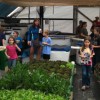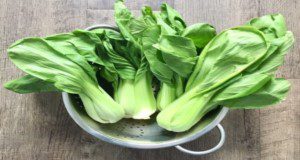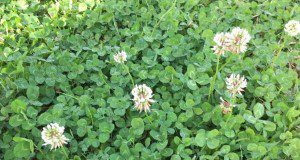Planning is the key to successful grove establishment, maintenance, and production. Developing a detailed infrastructure description and plan, cultural program, and financial and marketing plan for a new or existing grove with a new fruit crop will save you time and money and help minimize mistakes. Prospective growers should compile and analyze information needed to select a grove site, establish the needed infrastructure, and develop maintenance plans for the plants and how the production will be marketed. This new 15-page publication of the UF/IFAS Horticultural Sciences Department presents an outline of the type of information growers need when establishing a tropical fruit grove or contemplating management or modification of an existing grove. Written by Jonathan Crane, Yuncong Li, Edward Evans, Fredy Ballen, and Jeff Wasielewski.
https://edis.ifas.ufl.edu/hs1387
Tag: Sustainable Agriculture
Bok Choy, an Asian Leafy Green Vegetable Emerging in Florida
Asian vegetable crops are rapidly expanding in Florida in the last decade due to their health benefits combined with their high profitability. These crops can help increase vegetable growers’ income and diversify Florida’s crop production, and they are new to most Floridians. This new 5-page article provides a general overview of bok choy for vegetable growers, crop consultants, certified crop advisors, Extension agents, and graduate students. Written by Hai Liu and Guodong Liu and published by the UF/IFAS Horticultural Sciences Department.
https://edis.ifas.ufl.edu/hs1337
Weeds as Reservoirs of Plant Pathogens Affecting Economically Important Crops
Weeds are a major contributor to yield loss and reduction in yield quality in an agricultural setting, competing with the crop for resources like light, water, and nutrients. This competition, along with the cost of weed management strategies like tillage and herbicides, is responsible for the economic impact of weeds, which can reach into the billions. Weeds can also harm crop plants by acting as reservoirs for destructive plant pathogens, the insect vectors that move these pathogens from plant to plant, or both. This new 7-page publication of the UF/IFAS Horticultural Sciences Department, written by Morgan Byron, Danielle Treadwell, and Peter Dittmar, summarizes previously published weed-pathogen associations to help growers scout and monitor pathogens in weeds near production areas.
https://edis.ifas.ufl.edu/hs1335
A Practical Guide for Aquaponics as an Alternative Enterprise
 Aquaponics is an intensive sustainable agricultural production system that connects hydroponic and aquaculture systems to produce multiple cash crops with reduced water and fertilizer inputs. It is highly suited for small farm producers targeting local markets and agritourism opportunities. This 10-page fact sheet was written by Richard Tyson and Eric Simonne, and published by the UF Department of Horticultural Sciences, September 2014.
Aquaponics is an intensive sustainable agricultural production system that connects hydroponic and aquaculture systems to produce multiple cash crops with reduced water and fertilizer inputs. It is highly suited for small farm producers targeting local markets and agritourism opportunities. This 10-page fact sheet was written by Richard Tyson and Eric Simonne, and published by the UF Department of Horticultural Sciences, September 2014.
http://edis.ifas.ufl.edu/hs1252
Cultivos en asocio, diversidad de cultivos y manejo integrado de plagas (ENY862S/IN932)
 El cultivo en asocio (o cultivo intercalado) es una práctica en donde se siembran diversos cultivos en un mismo campo. Adicionalmente plantas que no son cultivos, tales como las malezas, cultivos rastreros o de cobertura, así como plantas del hábitat, se pueden combinar en el espacio y tiempo para influir en el número de plagas o artrópodos benéficos en un cultivo principal. This 7-page fact sheet was written by Hugh Smith y Oscar Liburd. Traducido por Ana Lucrecia MacVean, and published by the UF Department of Entomology and Nematology, June 2012.
El cultivo en asocio (o cultivo intercalado) es una práctica en donde se siembran diversos cultivos en un mismo campo. Adicionalmente plantas que no son cultivos, tales como las malezas, cultivos rastreros o de cobertura, así como plantas del hábitat, se pueden combinar en el espacio y tiempo para influir en el número de plagas o artrópodos benéficos en un cultivo principal. This 7-page fact sheet was written by Hugh Smith y Oscar Liburd. Traducido por Ana Lucrecia MacVean, and published by the UF Department of Entomology and Nematology, June 2012.
http://edis.ifas.ufl.edu/in932
Intercropping, Crop Diversity and Pest Management (ENY862/IN922)
Growing different crops in the same field and/or planting different crops on the same plot during different times of the year can reduce insect pest populations, increasing beneficial insects, and suppress weeds. In addition, non-crop plants such as weeds, cover crops, and habitat plantings can be combined in space and time to influence numbers of pest and beneficial arthropods on the main crop. This 7-page fact sheet was written by Hugh A. Smith and Oscar E. Liburd, and published by the UF Department of Entomology and Nematology, February 2012.
http://edis.ifas.ufl.edu/in922
Sustainability of Agriculture in Miami-Dade County: Considering Water Supply (ABE380/AE429)
Developing sustainable agricultural practices in Miami-Dade County (Figure 1) is important to ensuring the future of its economically significant winter vegetable, tropical fruit, and ornamental nursery plant production. This 8-page fact sheet discusses water availability, factors that influence water availability, agricultural water use, and irrigation efficiency as they relate to Miami-Dade County. It was written by Kati W. Migliaccio and published by the UF Department of Agricultural and Biological Engineering, January 2011.
http://edis.ifas.ufl.edu/ae429
AE435 Greenhouse Gas Mitigation in Forest and Agricultural Lands: Carbon Sequestration
AE435, an 8-page fact sheet by Solomon G. Haile, Clyde W. Fraisse, Vimala D. Nair, and P.K. Ramachandran Nair, addresses some basic questions regarding the prospects of carbon (C) sequestration in forest and agricultural lands and examines the C sequestration potential of different land management practices that could play a role in GHG mitigation strategies. Includes references. Published by the UF Department of Agricultural and Biological Engineering, September 2008.
http://edis.ifas.ufl.edu/AE435
ENY-847/IN761 Biology and Management of Aphids in Sustainable Field Production of Cucurbits
ENY-847, a 3-page illustrated fact-sheet by O. E. Liburd and T. W. Nyoike, provides information about aphids, their biology and lifecycle, damage, monitoring and management strategies for sustainable agriculture. Includes references. Published by UF Department of Entomology and Nematology, January 2008.
http://edis.ifas.ufl.edu/IN761


